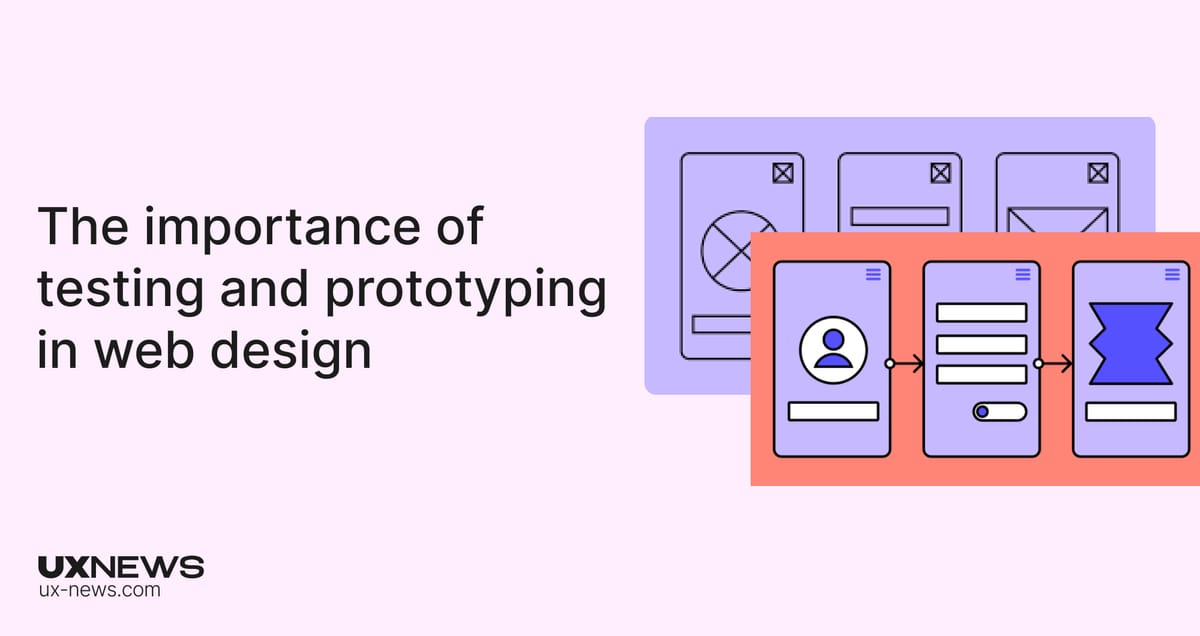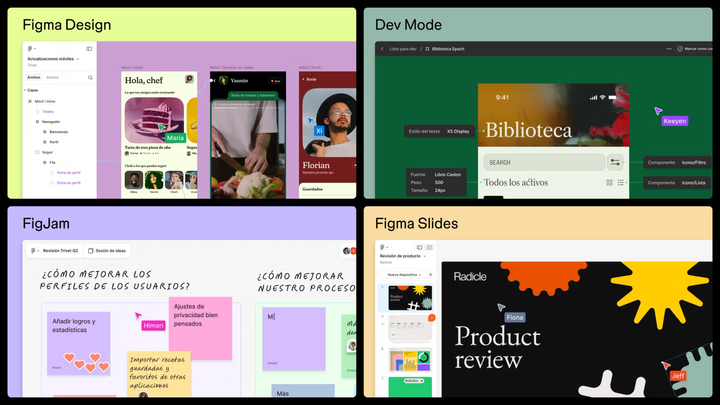The importance of testing and prototyping in web design
Prototyping helps to turn ideas into reality, visualize them, and identify and fix any issues early on. Testing ensures that these ideas function well in real-world scenarios. Together, these two processes form a cycle that allows to create high-quality, intuitive interfaces for users.

Web design is not only about creating visually appealing designs, but also about solving business and user challenges. The interface needs to be intuitive, functional, and efficient in order to provide a great user experience. Prototyping and testing are essential processes that help turn abstract ideas into concrete solutions. This article will explain why these processes are important, how they work, and the tools used to achieve these goals.
Prototyping: Visualizing Ideas
Prototyping is a process that involves creating a rough version of a web product to help visualize the structure, logic, and user experience. There are several different types of prototypes that can be used.
Low-fidelity prototypes are paper sketches or simple layouts that do not include interactivity.
Advantages:
- They are quickly created and cost almost nothing, which makes them a great option for small projects.
- Changes are easily made, allowing for flexibility and adaptability.
- They help focus on the functionality of the product, rather than on its visual appearance.
- The lack of details makes it easier to imagine how the final product will look and function.
- Stimulating new ideas and creativity is a positive aspect of using prototypes.
Disadvantages:
- There are few details in a prototype, so it can be difficult to fully imagine the final product's appearance and functionality.
- Testing on real users may be challenging, as it may not accurately reflect how they will interact with the product in real life.
- Misunderstandings within the team or between the client and the development team can occur, leading to delays or errors.
- Prototypes are not suitable for more complex projects, as they may lack the necessary features and functionality.

Mid-fidelity prototypes are digital mockups with minimal interactivity.
Advantages:
- They are well-developed enough to understand the logic and path of the user.
- Suitable for testing on real users.
- More understandable to the team and customers than simple sketches.
- Easy and fast to update.
- Cheaper and simpler than highly detailed models.
Disadvantages:
- Don't reveal the final design.
- Take more time and skill than simple prototypes
- Don't allow to fully evaluating the user experience.
- There's a risk of wasting time on unnecessary details.

High-fidelity prototypes: are fully interactive prototypes that closely resemble the final product.
Advantages:
- Accurate representation of products
- Clear communication with team and client suitable for full-scale testing
- Used in customer presentations
- Errors can be identified early
- Suitable for full-fledged testing
Disadvantages:
- Creating a design can take a lot of time and effort.
- Changes may be difficult to implement.
- Only the visual aspects of the design can be focused on.
- Testing the interactivity of the design may be challenging.
- There is a risk of spending time on unnecessary details.

The prototypes demonstrate how the interface will appear and function, allowing you to rapidly assess its performance.
Why is prototyping important?
1. Saving time and resources:
Prototyping allows identifying and fix bugs at an early stage. Making changes at the draft level is cheaper than making changes to the final product.
2. Vision alignment:
The prototype serves as a bridge between designers, developers, and customers. It is a visual representation of the idea that helps everyone involved achieve a common understanding of the project.
3. Focus on UX:
By creating prototypes, designers can focus on the user experience. They can think about how users will navigate between pages, find information, and interact with features.
4. Speeding up iterations:
It's convenient to quickly refine prototypes based on user feedback or team suggestions.
5. Reducing the risk of failure:
Prototyping allows you to test ideas and determine which concepts don't work before investing in development.
Testing: hypothesis testing and design improvement.
Testing is a process of evaluating the design to identify problems and ensure that the interface meets its goals. The primary purpose of testing is to create an interface that satisfies user expectations and helps businesses achieve their objectives.
Types of testing:
1. Usability Testing
This is an evaluation of the user experience of the interface. The aim is to understand how easily users can complete their tasks.
For example:
- How quickly can users find the correct section?
- Do they understand how to place an order easily?

2. A/B Testing
Compare two versions of the interface to determine which one is more effective.
For example:
-Does change the button color affect conversion rates?
-Which headline attracts attention more?

3. Functional Testing
Testing how buttons, forms, menus, and other interface elements function. This ensures that all features are working correctly.
For example:
-Form validation (testing the sending of data via contact forms, registration forms, or other forms)
-Button and link functionality (checking that all buttons are clickable and perform their intended function correctly, such as the "Add to Cart" button)
-Interactive elements (testing the operation of dropdown menus, sliders, tabs, and carousels)

4. Cross-Browser Testing
This helps to ensure that a design functions correctly across different browsers (such as Chrome, Safari, and Firefox) and devices (mobile phones and tablets).
For example:
- Checking the interface display (testing the correct display of fonts, colors, and styles in different browsers)
- Performance (checking the page loading speed in different browsers. For example, Safari can work faster with animations than Firefox.)
- Multimedia support (checking video and audio playback. For example, a video may work in Chrome, but not play in other browsers)

5. Analyzing the user's journey
Analyzing the route that a user takes to complete important tasks, such as placing an order, helps us identify points where they may get stuck or experience difficulties.
For example:
- Login verification (after visiting the main page, the user finds the registration form and fills in the required information to create an account successfully.)
- Site navigation (the user can navigate through the menus and sections of the website to find the information they need, such as contact information for the company.).
- Subscription registration (the user chooses a subscription plan, provides payment details, and activates the service successfully.)

Why is testing important?
1. Ensuring user-friendliness
Testing helps to understand how well the interface meets users' expectations. If a product is difficult or inconvenient to use, users will abandon it, even if it has a visually appealing design.
2. Conversion growth
Testing hypotheses helps to find effective solutions that increase the number of purchases, registrations, or other targeted actions.
3. Reducing the risk of errors
Without testing, errors can lead to negative experiences for users and damage the brand's reputation.
4. Improving the user experience
Testing helps to identify areas where the user experience can be improved, making it simpler and more convenient for users.
5. Resource optimization
Correcting errors after a product launch is significantly more expensive than identifying and fixing them during the development phase.
How are prototyping and testing connected?
Prototyping and testing form a cycle. The prototype provides a basis for testing, which in turn provides data to improve the prototype. This cycle continues until the product reaches a comfortable and functional state.
Example of a cycle:
1. Creating a prototype: The designer creates a rough version of the design.
2. Prototype testing: Users test the prototype to see how easy and intuitive it is to use.
3. Making changes: Based on the feedback from testing, the designer makes improvements to the prototype.
4. Retesting: The updated prototype is tested again to ensure that the changes have been successful.
A practical example of testing:
Based on statistics from Toast, simply changing the color of the "Add to Cart" button has been shown to increase conversions by several percents.

Prototyping and testing tools
Prototyping
1. Figma: A leader in creating interactive prototypes with a user-friendly interface and a wide range of functionality.
2. Adobe XD: A versatile solution with animation and interactive tools.
3. Sketch: Ideal for user interface design, although it may not be as flexible for creating interactive prototypes.
4. Axure: Suitable for building complex interactive prototypes.
Testing
1.Hotjar: Provides insights into how users interact with the interface (heat maps, clicks, behaviors).
2.User testing: Gathers feedback from real users to improve your product.
3.Google optimize: Allows to run A/B testing to see which version of the product performs better.
4.Browser stack: Ensures the website works across different browsers and platforms.
5 Maze: Helps to conduct usability tests using prototypes from Figma and Sketch.
Conclusion
Prototyping and testing are essential steps in creating a successful web design. Prototyping allows to quickly implement ideas and visualize them, as well as fix bugs at an early stage. Testing ensures that these ideas function well in practice. Together, these steps form a process that helps you create high-quality and functional products that meet user expectations and business goals.
These steps should be included in the web design workflow, as they are necessary to create a modern and effective product. By following these steps, you can ensure that the product meets the needs of users and achieves its intended goals.



